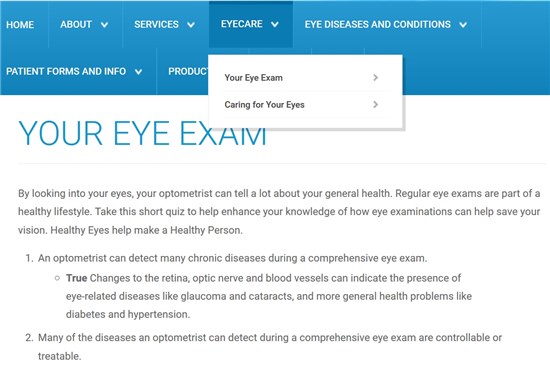By Scott Huffer, OD, FAAO
Sept. 21, 2016
Like many practices, ours has been challenged with finding effective recall methods. We want to ensure patients return annually for a comprehensive exam, and that those with conditions requiring follow-up receive the care they need. Recent changes we made to our recall system have benefited patients and boostedour practice profitability.
The changes we made this year to our recall system, including investing in an outsourced patient reactivation service, will add up to as much as $144,000 annually in additional revenues.
The page on Dr. Huffer’s web site that educates patients about the importance of returning annually for a comprehensive exam. Dr. Huffer says the doctor’s education of the patient in the exam about the medical eyecare reasons to return to the practice each year is an essential part of the patient recall process.
Evaluate Current System
Before April 2016, we were sending one postcard when a year had gone by since the patient’s last visit. We then were not contacting patients again, ever.
Get Outside Help for Recall
I talked with representatives of patient reactivation service, National Recalls, at a Leadership OD meeting in San Diego in January 2016. They introduced me to the concept of reactivation of patients, in which patients who have not been back to the practice for more than a year are sent messages via multiple channels, including phone, postal mail, e-mail, and even text message. We started utilizing them two hours a week to call patients who have not been in for two years.
Measure Additional Patients in the Office
We are averaging about 20 patients a month being booked through National Recalls. It’s hard to quantify how many of those patients would have come in to the office anyway, but not as quickly.
I would say we get a 10X return on our investment in National Recalls in gross sales. National recall costs us $290/month. We average $400 of gross revenue per exam. That comes to: $8,000 of monthly gross revenue for $300 spent.
It is really the old adage of it is cheaper to keep a patient than to acquire a new one. We noticed many patients were stretching time between appointments, and saw an opportunity to take better care of them, and for us to benefit as well.
My schedule, and those of the other doctors in the practice, are all full out about a week now compared to before April, before we started using National Recalls, when our schedules had significant gaps. Some of that is the natural cycles. But I would estimate that we are seeing 30 patients more a month just from postcards sent to patients who haven’t been back to see us in 18 months.
Measure Added Revenues
The benefits to our bottom line of our more effective recall has equaled 30 more patients per month at a little over $400 gross revenue per exam on average. That adds up to about $12,000 of additional monthly revenue, which we can project will up to an additional $144,000 annually.
Related ROB Articles
Speak Up: Be Prominent in Your Community
Extend the Back-to-School Opportunity Year ‘Round
Seeing Patient Regularly: Supply the Why
In addition to an effective recall system, the doctor plays an essential role in the process. In fact, the doctor begins the recall process by educating patients before they ever leave the exam room on when they would like to see the patient again.
I believe every patient should have an eye exam annually. I tell every patient this that at least once before they leave the exam room.
It is important to let patients know that just because they see clearly doesn’t mean their eye health is necessarily good. I tell patients how they see, and the health of their eyes, is not directly related. I tell them glaucoma, in particular, has no symptoms until the end stages. I like to say half of what we do is make sure you see well, and the other half is making sure you are going to continue to see well.
I reference the American Optometric Association slogan, “Check yearly and see clearly,” and the Think About Your Eyes campaign is also pushing this message. There will always be people who don’t listen, but I believe it moves even those patients to a shorter recall–maybe two years per comprehensive exam instead of three.
Communicating the importance of the annual comprehensive exam is critical in making patients think of their appointments as something other than a means to update their glasses. I think the message at the appointment is almost as important. Even if someone has perfectly healthy eyes there is an opportunity to present this message. I tell people: “Your eyes are perfectly healthy, and I would like you to keep them that way. It is important to protect your eyes from the sun, and if you are doing something that requires safety glasses, please wear them.”
If a patient has even mild pathology, like mild blepharitis or a pinguecula, I take the time and explain the diagnosis and offer treatment before symptoms arise. Patients are able to understand in the exam room the importance of returning in a year for their next comprehensive exam.
Scott Huffer, OD, is a partner with with Drs. Helfman, Lasky & Associates in Nashua, N.H. To contact: eyedocscott@gmail.com




























